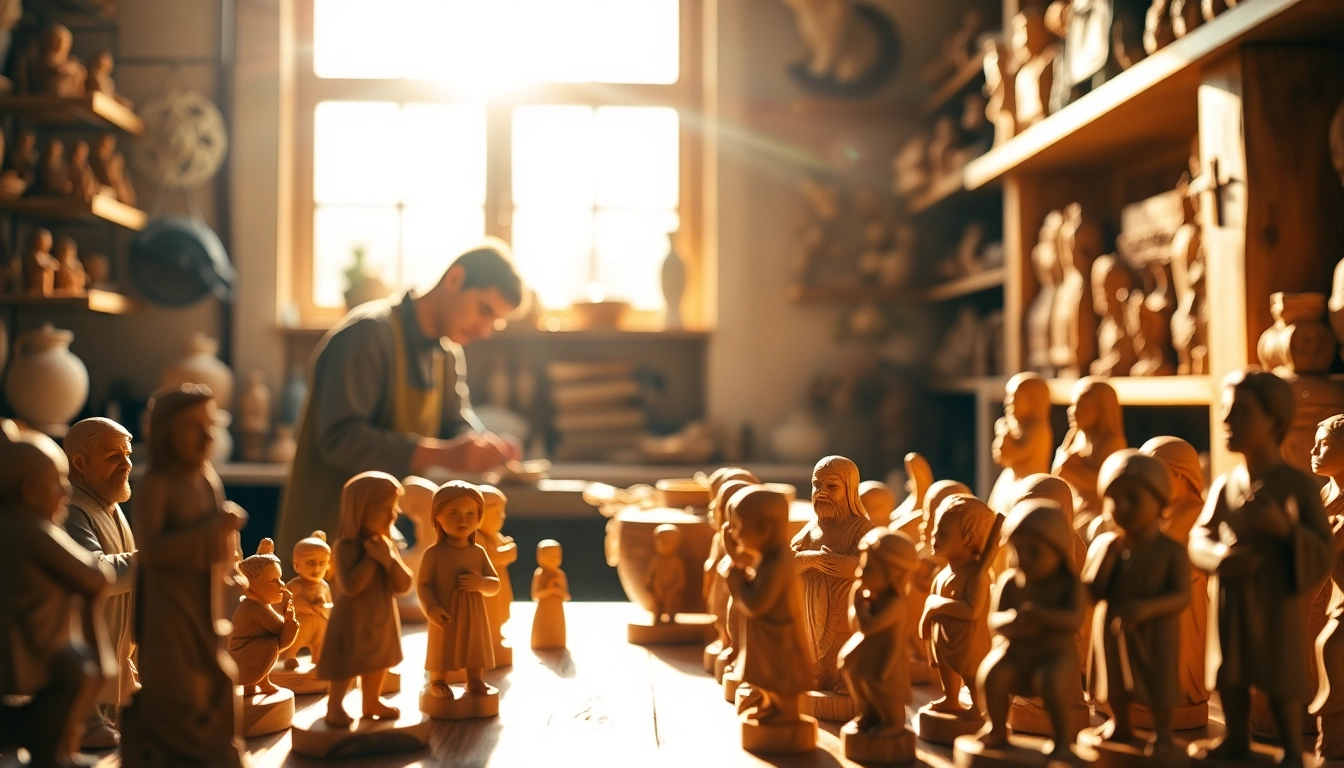Exceptional Olive Wood Carvings: The Art of Craftsmanship and Their Significance
Understanding Olive Wood Carvings
Olive wood carvings hold a special significance in the realm of craftsmanship and art, deeply intertwined with cultural, religious, and historical narratives. As you explore the rich heritage and intricate artistry associated with these handcrafted creations, you will discover not only the beauty of the works themselves but also the stories behind them. From their origins in the sacred groves of the Holy Land to their transition into treasured mementos and decorative pieces, Olive wood carvings captivate admirers across the globe.
History of Olive Wood Carvings
The practice of carving olive wood dates back centuries, rooted in the historical landscapes of the Mediterranean region, particularly the areas around Israel and Palestine. The olive tree holds great significance in many cultures, recognized for its resilience, longevity, and the nourishment it provides. The earliest examples of olive wood carvings can be traced to religious artifacts crafted for churches and homes. Artisans in Bethlehem have preserved this tradition, using techniques passed down through generations.
Importance in Cultural Traditions
For many communities, olive wood carvings are not just decorative objects; they embody cultural heritage, faith, and identity. In Christian traditions, these carvings often depict religious figures, scenes from the Bible, and symbols of faith such as crosses. They serve as a tangible connection to the sacred practices and beliefs that have shaped the lives of countless individuals over the years. Additionally, olive wood carvings are frequently presented as gifts for significant religious occasions, symbolizing blessings and remembrance.
Craftsmanship Techniques
The craftsmanship behind olive wood carvings is a meticulous process that requires both skill and patience. Artisans begin by selecting high-quality wood, typically from the prunings of olive trees that are no longer productive for olive oil production. This sustainable practice demonstrates respect for nature and the tree’s legacy. Carving techniques may vary, including intricate chiseling and detailed engraving, showcasing the artisan’s talent and creative expression. The unique grain patterns of olive wood add character to each piece, ensuring that no two carvings are alike.
Types of Olive Wood Carvings
As you delve deeper into the world of olive wood carvings, you will encounter a variety of forms that cater to different tastes and purposes. Each type offers a unique appeal, whether for decorative, spiritual, or functional use.
Figurines and Statues
Figurines and statues are among the most popular types of olive wood carvings, often depicting religious figures such as saints, angels, and the Nativity scene. These pieces can range from small, intricate carvings suitable for personal altars to larger sculptures that serve as focal points in homes or places of worship. The artisans’ attention to detail ensures that each representation captures the essence of its subject, making these carvings not only visually pleasing but also spiritually resonant.
Religious Symbols
Religious symbols carved from olive wood often serve as reminders of faith. Crosses, for instance, are a common form of artwork. They can be ornate or simple, with designs reflecting personal or communal faith experiences. Other symbols may include the fish (Ichthys), doves, and depictions of biblical events, such as the Last Supper or the Crucifixion. These pieces are often used in liturgical settings or as personal reminders of beliefs and values.
Decorative Objects
In addition to religious artifacts, olive wood is also fashioned into a variety of decorative objects. These can include bowls, serving utensils, and home decor pieces such as candle holders and art displays. The natural beauty of olive wood, with its rich hues and striking grain patterns, makes these items visually appealing and functional. Their unique characteristics ensure they become cherished additions to homes, often captivating guests and sparking conversations about their cultural significance.
How to Choose Quality Olive Wood Carvings
When purchasing olive wood carvings, several factors can help you identify high-quality pieces that are crafted with care and respect for tradition. Understanding these criteria will enable you to make informed choices that align with your aesthetic preferences and values.
Identifying Authentic Craftsmanship
Authentic olive wood carvings are typically handcrafted by skilled artisans who possess inherent knowledge and experience in their trade. Look for signs of genuine craftsmanship, such as the overall finish of the carving, the presence of unique grain patterns, and the intricacy of details. Unlike mass-produced items, authentic pieces may exhibit slight imperfections, which add to their charm and character.
Understanding Wood Quality
The quality of the wood used in carvings has a significant impact on the durability and beauty of the final product. High-quality olive wood is dense, heavy, and richly colored, with a smooth texture. Ensure that the carving has been treated with natural oils to enhance its appearance and protect it from moisture. Good quality olive wood will also have a pleasant scent, which is an indicator of its authenticity and craftsmanship.
Evaluating Artistic Detail
Pay attention to the artistic detail present in the piece. A well-crafted olive wood carving will have refined details that reflect both the skill of the artisan and the intended representation. Look for character in facial expressions, posture, and the intricacy of clothing and accessories. These elements contribute to the overall narrative and emotional impact of the piece, making it much more than just an object of decor.
Caring for Olive Wood Carvings
To ensure the longevity and beauty of olive wood carvings, proper care and maintenance are essential. With the right practices, these unique pieces can last for a lifetime or even be passed down through generations.
Cleaning and Maintenance Tips
Cleaning olive wood carvings involves gentle techniques to preserve their integrity. Use a soft, dry cloth to dust off the surface regularly. For deeper cleaning, a damp cloth can be used, but make sure to avoid soaking the wood. After cleaning, it’s beneficial to apply a light coat of mineral oil to maintain the wood’s luster and prevent it from drying out.
Protection from Damage
Olive wood carvings should be kept away from direct sunlight, as prolonged exposure can fade the colors and dry out the wood. Additionally, avoid placing them near heat sources such as radiators or stoves. For decorative items, using coasters or fabric under heavy objects can help protect them from scratches and pressure marks.
Longevity Practices
To promote the longevity of olive wood carvings, consider their humidity and temperature environments. A stable climate is best, as fluctuations can cause wood to expand and contract, leading to cracks. If displaying near indoor plants or aquariums, monitor moisture levels to prevent excess humidity. Regularly checking on your carvings and applying condition treatments as needed will contribute to their lifespan.
Where to Buy Olive Wood Carvings
Finding authentic olive wood carvings can be an exciting journey, especially as you discover the artistry and storytelling behind each piece. Here are some options for sourcing these unique works of art.
Local Artisan Shops
One of the best ways to purchase olive wood carvings is by visiting local artisan shops, especially those that specialize in handmade crafts. Supporting local artisans not only ensures you receive quality items but also fosters community connections. Many artisans will share their stories, techniques, and the inspiration behind their creations, enriching your purchasing experience.
Online Marketplaces
In today’s digital age, numerous online marketplaces offer a wide array of olive wood carvings. When shopping online, look for platforms that highlight the artisans and provide detailed descriptions of the products, including material quality and craftsmanship. Read customer reviews and inquire about return policies to ensure a satisfactory purchase experience.
Support for Artisans
Supporting artisans through the purchase of olive wood carvings contributes not only to the preservation of ancient craftsmanship but also to the livelihoods of those who practice it. Many artisans provide vocational training to emerging craftsmen, ensuring that the skills are passed down and continue to thrive. By investing in these artworks, you are participating in a cycle of cultural respect and appreciation.














Post Comment